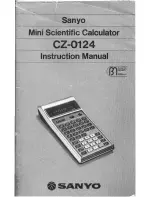
Appendix A: Anti-tips - things that can't be done
This section lists some things that you may want to do, or might think you should be able to do, but the
TI-89 / TI-92 Plus or TI Basic do not support. This section might save you some time in finding out that
you can't implement a particular feature.
1.
Your programs cannot, in general, use the text editor or matrix editor - but see tip [7.10].
2.
You cannot write to a text variable.
3.
Many built-in functions, for example, nSolve() and NewPlot, won't accept local variables as
arguments. Use global variables, and delete them with DelVar when your program exits.
4.
The TI-89 / TI-92 Plus do not have built-in functions to create cascading drop-down menus, as
used, for example, on the home screen toolbar items. However, the program MnuPak
(http://www.calc.org/programs/proginfo.php?id=2716) can be used to do this.
5.
Variables cannot be larger than about 64K. Trying to create or use a variable larger then this will
cause a memory error, and subsequent memory leakage, in which the available RAM mysteriously
decreases. The only known fix is a reset.
6.
A program cannot archive itself. However, one program can archive and unarchive another.
7.
Functions can read from global variables, but cannot store to (write to) global variables. Programs
can read and write to global variables. Functions can write to their argument variables, which are
considered local variables.
8.
Functions cannot write to the program I/O display.
9.
Programs cannot, in general, return results to the history area, but see tip [7.8].
10. You cannot reference single-row or single-column matrices (vectors) with a single index. Example:
matrix[3] won't work. This works: matrix[3,1].
11. You cannot use just ans() in a function. The TI Basic tokenizer will replace ans(1) with the actual
value of ans(1) the first time the program runs. Instead, use expr("ans(1)"). See tip [9.10] for an
example. This behavior can also be avoided by archiving the function before running it. entry()
exhibits the same behavior.
12. You cannot delete statistics plot definitions within a program or function. There is no command to
do this. However, see tip [4.15] for a possible work-around.
13. You cannot directly write to data variable elements. See tip [3.8] for a workaround.
14. Number base conversions (
▶
Hex,
▶
Dec,
▶
Bin) only work in Auto or Exact modes. In Approximate
modes, the base conversions return a Domain error message. Keep this in mind if you write
programs that use the number base conversions.
15. You must use global variables, not local variables, to do symbolic math in programs. This is in the
89/92+ Guidebook, page 291.
16. You cannot archive variables beginning with the underscore character '_'. The operating system
considers these to be system variables and prevents the archive. The underscore character is
typically used to define custom user units.
17. You cannot pass Data variables as program or function arguments. If this is necessary, convert the
data variable to a matrix (if all the columns have the same number of rows), and pass the matrix.
See tip [3.29] for details.
18. You cannot use elements of lists or matrices as arguments in the Request command. To
accomplish this, first store the element to a variable, use the variable in Request, then store the
variable to the element.
A - 1
Summary of Contents for TI-92+
Page 52: ...Component side of PCB GraphLink I O connector detail 1 41...
Page 53: ...LCD connector detail PCB switch side 1 42...
Page 54: ...Key pad sheet contact side Key pad sheet key side 1 43...
Page 55: ...Key cap detail 1 44...
Page 57: ...Component side of PCB with shield removed A detail view of the intergrated circuits 1 46...
Page 410: ...void extensionroutine2 void Credit to Bhuvanesh Bhatt 10 4...
















































